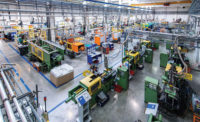WASHINGTON - A federal strategy and support is critical if American manufacturers are to thrive in the post-recession global economy, leading U.S. manufacturing experts said this week.
“U.S. manufacturers absolutely must have innovative energy-efficient and productivity-enhancing technology to be competitive,” Keith Nosbusch, Rockwell Automation Inc. chairman and chief executive officer told a press briefing at the National Press Club.
This transformation to smarter, safer and more sustainable manufacturing provides an opportunity for the federal government to help develop and make innovations in American plants to keep them competitive and to promote a sustainable U.S. manufacturing employment base, according to speakers.
“We all are pleased that President Obama has named a manufacturing czar to coordinate federal policy and programs to help U.S. manufacturers,” Nosbusch says. “Up until 1990, federal support for applied research – which is most critical for manufacturing – was equal to federal funding for basic science. But today it is about 30% lower with nearly a $10 billion gap that needs to be remedied.”
U.S. industry is in a battle not just with countries with lower costs, but also with developed countries that are investing in new technology, says Emily DeRocco, president of the Manufacturing Institute and vice president of the National Association of Manufacturers.
“With high quality, inexpensive products flooding the market from every corner of the globe, competing on cost alone is a losing battle for most U.S.-based manufacturers,” DeRocco says.
The cost of manufacturing in the United States is nearly 18% higher than in America’s nine largest trading partners, she said. That puts the 13.8 million manufacturing jobs in the United States at risk. The European Union already has allocated about $2 billion to encourage its manufacturers to invest in the next generation of technology for energy efficiency and productivity.
“To stay in the game, American companies must differentiate themselves through innovation,” DeRocco says. “Only those countries that invest in innovation and a highly skilled workforce will stay competitive.” Most energy efficiency has come from implementation of new technology, says R. Neal Elliott, associate director of research at the American Council for an Energy-Efficient Economy.
“We estimate that two-thirds of energy efficiency gained in the past 20 years has come from the application sensors and controls,” Elliott says. “We can reduce manufacturing energy intensity by more than half in the next 20 years as we begin to integrate smart technology not just into equipment but into entire manufacturing systems, plants and ultimately into the entire supply chains.”
Federal policy needs to support three things: research, a level playing field for trade, and a tax and regulatory environment that spurs innovation, says Thomas J. Duesterberg, president and chief executive officer of the Manufacturers Alliance/MAPI.
“It is high time for Washington to recognize that the policy environment matters to the ability of manufacturers to compete successfully in our globalized economy,” Duesterberg says. “‘Smart, Safe and Sustainable Manufacturing’ is not a slogan. It’s a blueprint for success in the world economy and improving our standards of living.”
Get our new eMagazine delivered to your inbox every month.
Stay in the know with Quality’s comprehensive coverage of the manufacturing and metrology industries.
SIGN UP TODAY!Copyright ©2024. All Rights Reserved BNP Media.
Design, CMS, Hosting & Web Development :: ePublishing


